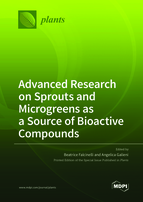Advanced Research on Sprouts and Microgreens as a Source of Bioactive Compounds
A special issue of Plants (ISSN 2223-7747). This special issue belongs to the section "Phytochemistry".
Deadline for manuscript submissions: closed (31 July 2022) | Viewed by 36228
Special Issue Editors
Interests: sprouts; microgreens; wheatgrass; phytochemicals; phenolic compounds; antioxidant activity; elicitation; food supplements
Interests: elicitation; abiotic stress; phytochemicals; sprouts; microgreens; yield quality; plant physiology; stress physiology; seed germination
Special Issue Information
Dear Colleagues,
In recent years, sprouts and microgreens have attracted increasing interest as a considerable source of bioactive compounds. In this context, the main challenge for the future is to design new plant products suitable for the agricultural, food and pharmaceutical industries. This topic is very wide, but the knowledge about it is still limited or lacking. For this reason, there is a big room and need for countless studies involving different disciplines of the biological sciences.
This Special Issue of Plants will collect and discuss advanced and innovative research aimed at (i) exploring the diversity of plant species and studying their wide range of bioactive compounds to identify species with the most suitable germinative and nutritional traits for sprouting purposes; (ii) using unusual and innovative elicitation strategies to improve the nutritional value of the sprouts and microgreens and to provide useful results for the development of technology in this sector; (iii) allowing the production of countless new enriched, and maybe nutraceutical, foods; (iv) deepening into beneficial health implications for both human and animal nutrition.
Dr. Beatrice Falcinelli
Dr. Angelica Galieni
Guest Editors
Manuscript Submission Information
Manuscripts should be submitted online at www.mdpi.com by registering and logging in to this website. Once you are registered, click here to go to the submission form. Manuscripts can be submitted until the deadline. All submissions that pass pre-check are peer-reviewed. Accepted papers will be published continuously in the journal (as soon as accepted) and will be listed together on the special issue website. Research articles, review articles as well as short communications are invited. For planned papers, a title and short abstract (about 100 words) can be sent to the Editorial Office for announcement on this website.
Submitted manuscripts should not have been published previously, nor be under consideration for publication elsewhere (except conference proceedings papers). All manuscripts are thoroughly refereed through a single-blind peer-review process. A guide for authors and other relevant information for submission of manuscripts is available on the Instructions for Authors page. Plants is an international peer-reviewed open access semimonthly journal published by MDPI.
Please visit the Instructions for Authors page before submitting a manuscript. The Article Processing Charge (APC) for publication in this open access journal is 2700 CHF (Swiss Francs). Submitted papers should be well formatted and use good English. Authors may use MDPI's English editing service prior to publication or during author revisions.
Keywords
- sprouting
- wheatgrass
- microgreens
- elicitor
- food supplementation
- phytochemicals
- phenolic compounds
- antioxidant activity








